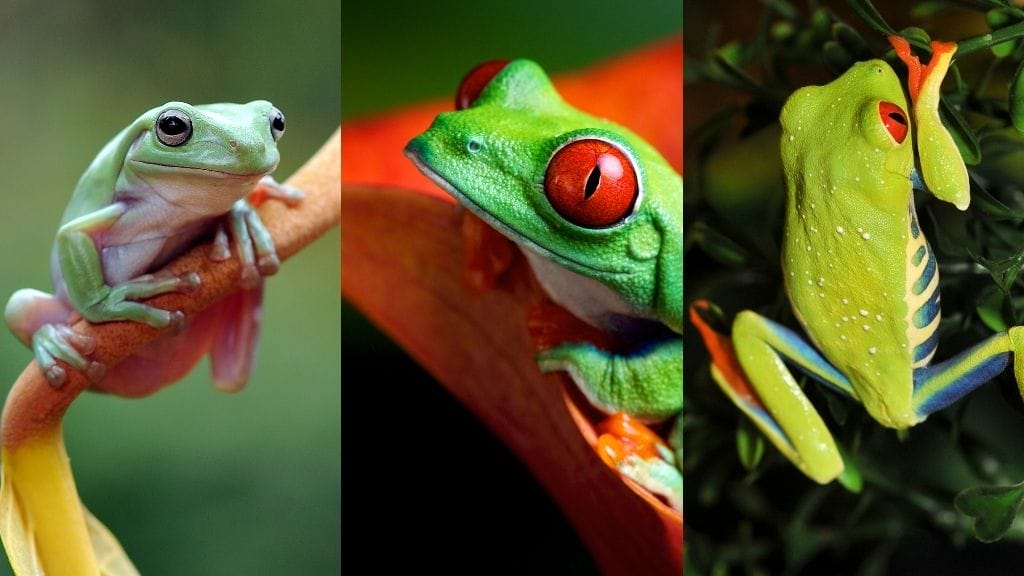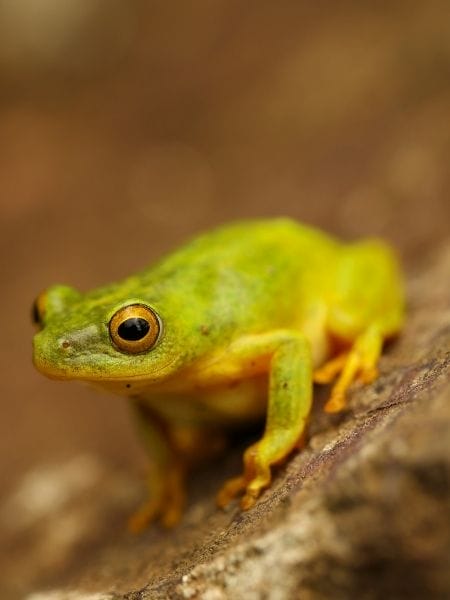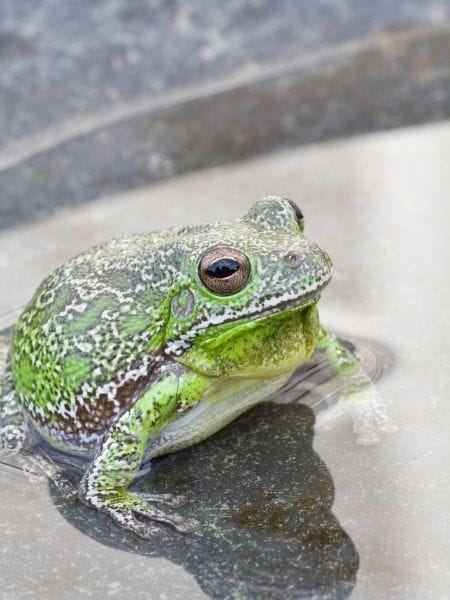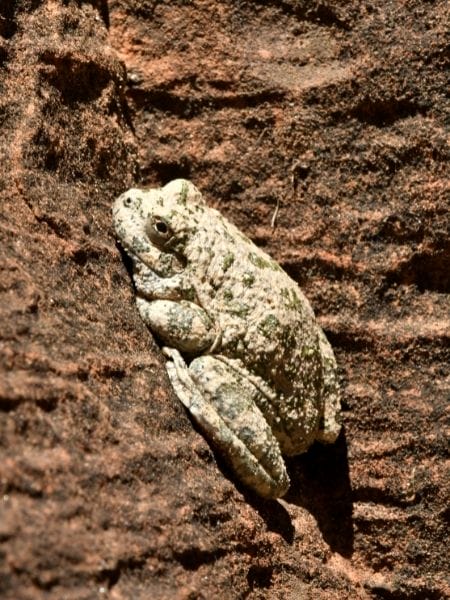10 Popular Tree Frog Identification With Pictures

If you want to get any specific tree frog as a pet, it may be a little bit hard to identify precisely among over 800 species. So, frog lovers often wonder about how to identify a tree frog.
Generally, tree frogs are smaller in size. Some unique features of tree frogs are their claw-shaped toes, long legs, extraskeletal structures and pads on toes, etc. These help them climb the trees and also rely on the leaves. All of these are the common signs to identify a tree frog.
Although the adult tree frogs are insectivorous, the juvenile tree frogs are herbivores. Moreover, each species of tree frog has different coloration on its skin. Such as green, brown, grey, yellow, and so on. Also, they have several spots on the rear of their thighs.
These mentioned characteristics are common in almost every tree frog.
Hence, I’ve conducted some researches to find out the ways to identify various types of tree frogs. In this article, you’ll get to know the identification characteristics of 10 popular tree frogs.
So, let’s go through this article, without any further ado.

1. Green Tree Frog
| Common Name | Green Tree Frog |
| Scientific Name | Hyla cinerea |
| Color | Bright green, duller green, greyish green, etc. |
| Length | 1.25-2.25 inch (3.2-5.7cm) |
| Weight (adult) | 50-90 grams |
| Habitat | These frogs can be found in human environments and near water areas. (Throughout the southeast, gulf coast, southern parts of Mississippi river valleys) |
| Identical Markings | White or yellow stripes on both sides of the body and golden spots on the back |
| Lifespan | Up to six years in captivity |
The most common name in the world of tree frogs is a green tree frog. From its name, you can easily guess that this is a green-colored frog.
Their skin coloration can be brighter green to duller green, yellow-green, or greenish-grey. Besides, green tree frogs have identical yellow or white-colored stripes along both sides of their body. Their stomach appearance is white or cream-colored. Also, you’ll notice golden spots on their back.
Like other tree frogs, green tree frogs also have long legs, claw-shaped toes, sticky toe pads, etc. So, this is pretty easy to identify a green tree frog smoothly.
Besides, green tree frogs are nocturnal and insectivorous. People often identify them trying to catch those insects which are attracted to light.
You’ll also find them near the porch, water areas, streams, lakes, marshes, or in the garden during the warm weather of late spring. On the other hand, you can find them in weedy ponds or swamps during their breeding season.
Although not all species of tree frogs are arboreal, green tree frogs spend a great time of their lives in trees.
Can You Touch A Green Tree Frog?
Seeing such timid tree frogs, any frog lover might want to touch or hold them. Although touching them is not deadly for a human, this act can be dreadful for tree frogs.
As tree frogs have absorbing and porous skin, you should not touch tree frogs. Even a small amount of soap, oil and any chemical from your hands can lead a tree frog to death. Hence, this will be better to avoid touching or holding tree frogs.
Moreover, touching a tree frog can make you suffer from vomiting, diarrhoea, cramps, uneasiness, and so on. Also, you must not rub your eyes after touching a tree frog.

2. Red-eyed Tree Frog
| Common Name | Red-Eyed Tree Frog |
| Scientific Name | Agalychnis callydryas |
| Color | Bright green |
| Length | 1.6-2.5 inch (male) 2.2-2.9 inch (female) |
| Weight | 6-15 grams |
| Habitat | Central America, Mexico, Columbia, Panama, etc. |
| Identical Markings | Blue and yellow stripes on each side of the body, bright red eyes, etc. |
| Lifespan | Approximately five years |
Red-eyed tree frogs look so unrealistically beautiful that everyone wants to own them as pets. This unique-looking frog has dazzling, bright green-colored skin, similar to the color of the leaf. Besides, you can identify them seeing blue and yellow stripes running on both sides.
The striking characteristic to identify a red-eyed tree frog is its forward-facing, startling, bright red eyes. So, there are no mistakes in identifying a red-eyed tree frog seeing a bright green body with red eyes!
Moreover, the red-eyed tree frog toes are orange to reddish colored. Even their stomachs are not entirely white. There is some orangish and blueish glitter.
These red-eyed tree frogs are also arboreal. Their skin coloration also helps them get blend with the leaves. Also, the sticky pads on their toes and fingers assist them in gripping onto branches.
Because of being insectivorous, the red-eyed tree frogs eat almost all types of insects like worms, crickets, moths, flies, etc. They use their sticky tongue to catch their prey and swallow entirely. However, you can find red-eyed tree frogs in the riverside areas of humid forests and lowlands.
Why Are The Tree Frogs Eyes Red?
The bright red color of the eyes of red-eyed tree frogs is known as startling coloration. The red-eyed tree frogs use the advantage of their red eyes as their defense mechanism.
As the red-eyed tree frogs are nocturnal, they remain active at night. So, these frogs hide behind leaves or branches during the daytime.
If these red-eyed tree frogs encounter their potential predators, they tend to display their bright red eyes to startle their enemies. This sudden appearance of bright red eyes makes their predators frightened. As a result, this act gives the red-eyed tree frogs some time to flee away.
So, the bright red eyes and dazzling skin colors are somewhat blessings to the red-eyed tree frogs.

3. Barking Tree Frog
| Common Name | Barking Tree Frog |
| Scientific Name | Hyla gratiosa |
| Color | Olive green, grey, yellowish, brown, etc. |
| Weight | Heavier bodied |
| Length | Over 2 inches (4.5 cm) |
| Habitat | Southern and Eastern South Carolina (wooded habitats and sandy areas) |
| Identical Markings | Whites lines on sides, dark spots on the back, and especially, their unique calls. |
| Lifespan | 8-10 years in captivity |
The name of the barking tree frog reveals there is something unique about their calling. Being skin-colored often makes them confusing to people. So, their calling is the easiest way to identify a barking tree frog.
The call of a barking tree frog sounds like tong or dong. Besides, the barking tree frogs repeat their calls every 1-2 seconds. Sometimes, people mistake their chorus for the sound of a barking dog from a distance.
So, it’s pretty easy to identify a barking tree frog hearing their unique calls or vocalizations.
Besides, the dark splotches or spots over their back are identical markings of a barking tree frog.
These frogs also have a thin white line from their lips to the downside of their stomach.
Although the green treefrog, squirrel treefrog, and barking tree frogs are green in color, these barking tree frogs have granular skin than those frogs.
Moreover, people usually find these frogs in high trees. They also have a disk-like projection on their toes that helps them climb trees.
Do Female Barking Tree Frogs Bark?
Barking tree frogs have earned such a catchy name for their barking-like calls. I’ve mentioned above that people can smoothly identify these frogs from a distance by hearing the barking-like chorus.
Generally, the male barking tree frogs make such barking-like mating calls to attract a female barking tree frog. So, the female barking tree frogs need not have to do such mating calls. In other words, they do not bark like the male barking tree frogs.
On the other hand, female barking tree frogs make noise occasionally whenever necessary.

4. Squirrel Tree Frog
| Common Name | Squirrel Tree Frog |
| Scientific Name | Hyla squirella |
| Color | Green, grey, brown, yellowish, etc. |
| Length | 1-1.5 inch (2.2-4.1 cm) |
| Weight | Approximately 1.8 oz |
| Habitat | South Eastern United States |
| Identical Markings | Smooth skin, yellowish upper lip, broken, whitish stripes at sides. |
| Lifespan | Around 8.5 years in captivity |
Squirrel tree frogs can be of several colors. Such as green, tan, grey, yellowish, brown, etc. The identification signs of squirrel tree frog are a bit hard.
Sometimes, you can notice them plain or spotted. Usually, their skin is smooth, unlike other tree frogs.
Some of these frogs have white broken or poorly developed yellowish stripes down their sides and bars between their eyes.
Besides, some of them might have white or brown blotches.
An easy way to identify a squirrel tree frog is their callings like squirrel chattering. Moreover, they usually start calling after a rain shower.
Hence, people entitle the squirrel tree frogs as rain frogs too. You might also find their callings like a nasal duck during their breeding period.
If you want to identify squirrel tree frogs, you need to search them in some specific areas. Such as bushes, gardens, trees, woods, streams, shrubs, logs, etc. Another identification sign is that these frogs are urbanized.
How Can You Tell The Difference Between A Green Tree Frog And A Squirrel Tree Frog?
Green tree frogs and squirrel tree frogs look pretty similar. So, this is hard to identify at a very first glance. But, there are some noticeable differences between these two frogs.
Let’s check those identification differences between a green tree frog and a squirrel tree frog.
- Green tree frogs have clear, whitish stripes on both of their sides. But, the white stripes of squirrel tree frogs are broken and poorly developed.
- The color of the upper lip of a green tree frog is white. On the other hand, a squirrel tree frog has a yellowish upper lip.
- The skin color of a squirrel tree frog can be bright green, grey, tan or brown, etc. But, the green tree frog can be only bright green.
- The calls or sound of a tree frog is kind of loud abrupt nasal bark. On the other hand, the calls of a squirrel tree frog are similar to the chirping of a squirrel.

5. Canyon Tree Frog
| Common Name | Canyon Tree Frog |
| Scientific Name | Hyla arenicolor |
| Color | Grey, tan, brown, or olive with splotches |
| Length | 2.5-5 cm |
| Weight | Up to 0.12 oz |
| Habitat | Stream banks or riverside of rocky areas in Southwest |
| Identical Markings | The inner part or inside of the hind legs is bright yellow. Moreover, they change their skin color to get blended with their surroundings. |
| Lifespan | Around 8-10 years |
Although many tree frogs have smooth skin, canyon tree frogs have rough skin. To describe the skin coloration of canyon tree frog is a bit hard.
They change their skin coloration matching with the rocks where they live around.
You can identify a canyon tree frog by their brown to grey colored skin. Besides, you will notice dark spots beneath their eyes.
Along with the change of sunlight exposure, their skin color changes from dark grey to light grey.
The identification sign of a male canyon tree frog is their dark throat patches, whereas the females have lighter-colored throats.
6. Bird Voiced Tree Frog
| Common Name | Bird Voiced Tree Frog |
| Scientific Name | Hyla avivoca |
| Color | Green, brown, or mottled grey with dark blotches on back |
| Length | Up to 3.5 cm |
| Habitat | Wooded swamplands of the Southern United States |
| Identical Markings | 1. Yellowish green or greenish or yellow colored hind leg portion. 2. wit-wit-wit sound or calls. |
| Lifespan | 5-9 years |
People often assume bird voiced tree frog is a large grey tree frog. There are some subtle signs to identify a bird-voiced tree frog.
Usually, the coloration of the skin of bird-voiced tree frogs is mottled grey. But, this coloration turns into green or brownish along with the change of temperature or activities. There is a white mark also under their bulging eyes like grey tree frogs.
You can distinguish a bird-voiced tree frog from a grey tree frog by noticing the hind leg. So, you can identify a bird-voiced tree frog if you see its concealed portion of the hind legs is greenish-yellow color.
However, such a catchy name of bird voiced tree frog is because of their vocalization. Their sound is almost similar to the melody of birds. So, their calls or vocalizations are also a significant way to identify them.
Besides, you can find them in low bushes, swamp woodlands, small trees, nearside areas of streams or rivers, etc. The bird-voiced tree frogs are also arboreal. Hence, they hardly come down to the ground from the trees.
What Does A Bird Voiced Tree Frog Sound Like?
Although the calls of maximum frogs aren’t so pleasant, the calls of a bird-voiced tree frog are sweet to hear.
The calls of bird-voiced tree frogs sound like wit-wit-wit-wit. The frogs sound like this rapidly and repetitively.
Some experts say that the sound of a bird voiced tree frog resembles the voice of northern mockingbirds.
7. Pine Woods Tree Frog
| Common Name | Pine Woods Tree Frog |
| Scientific Name | Hyla femoralis |
| Color | Tan, grey, brown, green, etc. |
| Length | 1-1.5 inch |
| Habitat | The Southern United States |
| Identical Markings | Triangular dark spots between eyes. Whitish yellow or orange spots on thighs. |
| Lifespan | Around four years |
The skin coloration of pinewood tree frogs varies from frog to frog. Their skin color can be tan, brown, grey, green, etc.
Pinewood tree frog’s identification starts with darker blotches or irregular bands over their body. You can also identify a pinewood tree frog by checking a row of distinctive orange or whitish-yellow spots on their thighs. Moreover, anybody can readily identify them seeing a triangular mark between their eyes.
The calls of a pine woods tree frog are kind of tapping or chattering sound, like morse wood. That’s why people call them morse code frogs. It is also a significant identification sign of the pine woods tree frogs.

8. Pine Barrens Tree Frog
| Common Name | Pine Barrens Tree Frog |
| Scientific Name | Hyla andersonii |
| Color | Bright green to light green |
| Length | Up to 1.5 inches |
| Habitat | USA, North Carolina, New Jersy, Alabama, etc. |
| Identical Markings | Purple stripes throughout their eyes down to each side of the body |
| Lifespan | 2-5 years |
These tiny pine barrens tree frogs are some of the most beautiful tree frogs. Their identification is also pretty easy for everybody.
You can easily identify a pine barrens tree frog with its bold purple stripes. These stripes start from their snout through eyes downing each side of the body. Also, the stripe has a yellowish-white border.
Moreover, their stomachs are white. When they jump, you can notice the orange patch beneath their hind legs. These are also strong identification signs of a pine barrens tree frog.
The calls of pine barrens tree frogs sound like nasal “quonk-quonk-quonk”.
On the other hand, you can identify these frogs only in acidic habitats, like pitch pine lowlands, sandhills, swamps, low areas covered with sphagnum moss, etc. Like other tree frogs, they are also insectivorous.

9. Gray Tree Frog
| Common Name | Gray Tree Frog |
| Scientific Name | Hyla versicolor |
| Color | Grey, greyish green, brown |
| Length | 1.25-2 inches |
| Weight | 0.25 oz |
| Habitat | Minnesota, Oklahoma, etc. |
| Identical Markings | Melodic, slower trill |
| Lifespan | Around seven years in captivity |
By the term ‘Two Grey Tree Frog’, it means two different species. One of them is the eastern gray tree frog, and another is the cope’s gray tree frog.
The skin of a grey tree frog is rough. Besides, the very first way to identify a grey tree frog is its grey-colored skin though the shade may vary. Some of them have pearl grey, green, or brown skin color. Also, you’ll notice black blotches on the back of the gray tree frogs.
These frogs often change their color to get mixed with their background. Another way to identify a gray tree frog is the orange or golden-colored skin of hind legs.
Another easy identification way is that any grey frog found in the southeast region is an eastern gray tree frog. No cope’s gray tree frog can be found in those areas.
But, the mating calls or vocalization is the only true way to identify an eastern gray tree frog.
The trill of a gray tree frog is melodic and slower, whereas the trill of a cope’s gray tree frog is faster.
10. Cope’s Gray Tree Frog
| Common Name | Cope’s Gray Tree Frog |
| Scientific Name | Hyla chrysoscelis |
| Color | Mottled green, light green, greyish green, etc. |
| Length | 3.2-5.1 cm |
| Weight | 7 gm |
| Habitat | Throughout the southeast |
| Identical Markings | High pitched mating calls |
| Lifespan | 7-9 years in captivity |
Cope’s gray tree frog is another species of grey tree frog and their resemblance is pretty uncanny.
You can identify a cope’s grey tree frog by its molted green or light green colored skin.
Besides, this tree frog often changes the skin color matching with the surrounding.
Moreover, you can identify a cope’s grey tree frog if you notice a light spot under the eyes. Also, bright yellow or orange skin on the inner thighs is another identification sign of this species.
The effective way to identify a cope’s grey tree frog is their rapid, musical, high-pitched trill.
However, you must take precautions while identifying a cope’s gray tree frog. These frog species secret toxins, and so touching them can cause deadly effects.
What Are The Differences Between A Grey Tree Frog And A Cope’s Gray Tree Frog?
This is pretty hard to distinguish between a grey tree frog and a cope’s grey tree frog. It is because both of the frogs have almost similar appearances, habitats, nature, etc.
The strong difference between a grey tree frog and a cope’s grey tree frog is their different call structure. The calls of cope’s grey tree frog sound like a fast metallic buzz. On the other hand, the grey tree frog trills are musical and slower than that of a cope’s grey tree frog.
So, you have to notice the trills to identify these frogs correctly. However, this happens due to unequal chromosome numbers.
Final Words
Although there are varieties of tree frog species, I’ve discussed the identification process of only ten popular tree frogs. So, I hope, this article has helped you get enlightened to identify a tree frog without any difficulty.
About Author
Hello, I’m Muntaseer Rahman, the owner of AcuarioPets.com. I’m passionate about aquarium pets like shrimps, snails, crabs, and crayfish. I’ve created this website to share my expertise and help you provide better care for these amazing pets.
Disclaimer
This site is owned and operated by Muntaseer Rahman. AcuarioPets.com is a participant in the Amazon Services LLC Associates Program, an affiliate advertising program designed to provide a means for sites to earn advertising fees by advertising and linking to Amazon.com. This site also participates in other affiliate programs and is compensated for referring traffic and business to these companies.

